The Field Museum
 The Field Museum in Chicago is the city's answer to New York's American Natural History Museum. It is located on South Lake Shore Drive and it houses a vast collection of scientific and biological exhibits. This post is the first of many, which will include other exhibits of the museum.
The Field Museum in Chicago is the city's answer to New York's American Natural History Museum. It is located on South Lake Shore Drive and it houses a vast collection of scientific and biological exhibits. This post is the first of many, which will include other exhibits of the museum.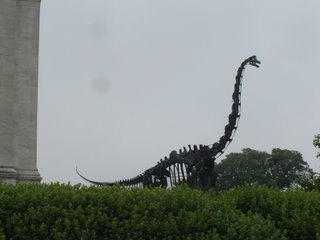 You are greeted right away with some of the fantastic items that are available here. The Field Museum was founded to house the biological and anthropological collections assembled for the World's Columbian Exposition of 1893.
You are greeted right away with some of the fantastic items that are available here. The Field Museum was founded to house the biological and anthropological collections assembled for the World's Columbian Exposition of 1893. Outside, Olmec Head Number 8 greets you. It is a gift from Mexico.
Outside, Olmec Head Number 8 greets you. It is a gift from Mexico.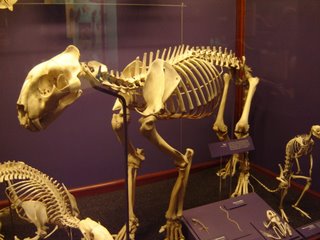 Here's what a tiger looks like when it's been dead for a while. This would be an example of an "endoskeleton," or inner bones. The word comes from the Greek word "inner". The Greeks rock!
Here's what a tiger looks like when it's been dead for a while. This would be an example of an "endoskeleton," or inner bones. The word comes from the Greek word "inner". The Greeks rock! One annoying quality in the permanent collection is the use of stuffed animals. The museum has a long history that predates current views on killing animals for display. Signs adorn various parts of the museum explaining the practice. They say that:
One annoying quality in the permanent collection is the use of stuffed animals. The museum has a long history that predates current views on killing animals for display. Signs adorn various parts of the museum explaining the practice. They say that:"Field museum scientist collected most of these animals more than fifty years ago on research expeditions around the world. Then, many species were more abundant.
"Long before television brought images of animals in their natural habitats into peoples' living rooms, museum exhibits of mounted specimens offered the opportunity for people to learn about animals from all over the world. Today, our displays still allow you to see what these animals, some of which are now endangered or extinct, look like up close and in their natural habitats."
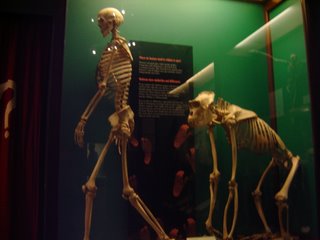 Here's a display that shows that humans and great apes, which include gorillas, orangutans and chimpanzees all evolved from a common ancestor. At least according to the theology of naturalism. It could be that God just wanted it this way.
Here's a display that shows that humans and great apes, which include gorillas, orangutans and chimpanzees all evolved from a common ancestor. At least according to the theology of naturalism. It could be that God just wanted it this way. Here are the impressive bones of the Black Right Whale. With meat and organs, a whale of this size could get up to be 120,000 lbs. It hangs precariously on the ceiling of the room, waiting to crush you.
Here are the impressive bones of the Black Right Whale. With meat and organs, a whale of this size could get up to be 120,000 lbs. It hangs precariously on the ceiling of the room, waiting to crush you. Dinosaur bones are some of the museum's best exhibits.
Dinosaur bones are some of the museum's best exhibits.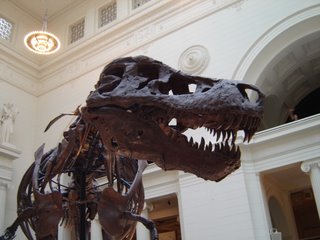 Sue, in particular, is one of the country's best known fossils, the largest, most complete and best preserved T. Rex discovered to date. Sue was found in South Dakota, and we're not sure if she's a boy or a girl.
Sue, in particular, is one of the country's best known fossils, the largest, most complete and best preserved T. Rex discovered to date. Sue was found in South Dakota, and we're not sure if she's a boy or a girl. Similar to the practice of stuffed animals, the Field Museum brings artificially duplicated foreign cultures to Chicago, and they have an entire section on Africa. The sign asks if one can name five African countries. I best most people cannot.
Similar to the practice of stuffed animals, the Field Museum brings artificially duplicated foreign cultures to Chicago, and they have an entire section on Africa. The sign asks if one can name five African countries. I best most people cannot.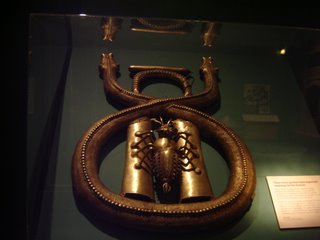 This double headed snake is important to the Bamum people. I've never heard of the Bamum people. Apparently, they are from the Cameroon grasslands. See, I learned something!
This double headed snake is important to the Bamum people. I've never heard of the Bamum people. Apparently, they are from the Cameroon grasslands. See, I learned something! There was an interesting, and brutally honest from a political correctness standard, description of slavery in Europe and the Americas. One sign discussed how African leaders helped Europeans establish the slave trade as one tribe would sell off their enemies to the white man.
There was an interesting, and brutally honest from a political correctness standard, description of slavery in Europe and the Americas. One sign discussed how African leaders helped Europeans establish the slave trade as one tribe would sell off their enemies to the white man.Between 1445 and 1870, European slavers seized 10 to 20 million Africans and turned them into slaves.
 The Field Museum does a great job mixing geology and nature with foreign cultures. This display showed Qing Dynasty (1644-1911) jade objects, like a bell, a screen, and white chime. This marked the second time period in which China was dominated by foreigners.
The Field Museum does a great job mixing geology and nature with foreign cultures. This display showed Qing Dynasty (1644-1911) jade objects, like a bell, a screen, and white chime. This marked the second time period in which China was dominated by foreigners. Here's a cross section of a sugar pine that lived a long and good live before mankind found it.
Here's a cross section of a sugar pine that lived a long and good live before mankind found it. Rare rocks, like this jointed stratified one, show how the pressures under our feet change the landscape we walk on. They had an educational display on the major geological processes of our planet, based on what we understand them to be today.
Rare rocks, like this jointed stratified one, show how the pressures under our feet change the landscape we walk on. They had an educational display on the major geological processes of our planet, based on what we understand them to be today.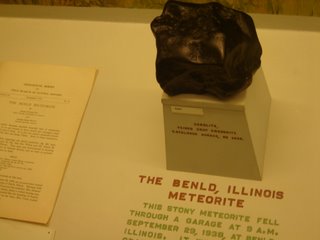 The Benld, IL meteorite is on display. In 1938 this fell through the roof of someone's home.
The Benld, IL meteorite is on display. In 1938 this fell through the roof of someone's home. Other meteorites have had more of an impact, like this famous one from Arizona, which created America's largest crater. By now, since I've mentioned it a couple of times, you'll know that I've been to our country's second largest crater in Odessa, TX.
Other meteorites have had more of an impact, like this famous one from Arizona, which created America's largest crater. By now, since I've mentioned it a couple of times, you'll know that I've been to our country's second largest crater in Odessa, TX.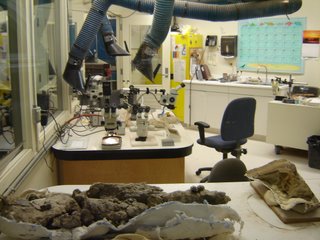 The Field Museum is an active place, and one of the work rooms is on display. The Carnegie Museum in Pittsburgh has a similar display, although that one had people in it. The museum website states that:
The Field Museum is an active place, and one of the work rooms is on display. The Carnegie Museum in Pittsburgh has a similar display, although that one had people in it. The museum website states that:The Museum's curatorial and scientific staff in the four departments of Anthropology, Botany, Geology, and Zoology conduct basic research in the fields of systematic biology and anthropology, and also have responsibility for collections management and collaboration in public programs with the Departments of Education and Exhibits. Since its founding the Field Museum has been an international leader in evolutionary biology and paleontology, and archaeology and ethnography.
 Tibetan artifacts are on display. The Dali Lama has been here to see it.
Tibetan artifacts are on display. The Dali Lama has been here to see it. For all of its concern for conservation and ecology, it has a McDonald's in its basement, and many environmentalist have been critical of the company (some to the point of lunacy). Of course, the corporation feels it is doing the right thing in this area. I guess it takes a lot of money to run a museum. On the surface, however, it seems to be quite the contraction: be nice to animals in most places but not in our basement.
For all of its concern for conservation and ecology, it has a McDonald's in its basement, and many environmentalist have been critical of the company (some to the point of lunacy). Of course, the corporation feels it is doing the right thing in this area. I guess it takes a lot of money to run a museum. On the surface, however, it seems to be quite the contraction: be nice to animals in most places but not in our basement.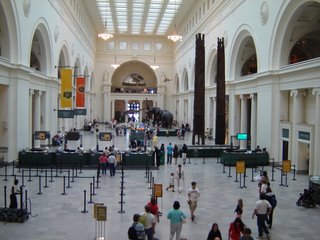 Nevertheless, it's a fantastic place to be. Check out my upcoming posts on the Tut exhibit, evolution, and the microscopic planet. There's so much to see here that one post cannot capture it all.
Nevertheless, it's a fantastic place to be. Check out my upcoming posts on the Tut exhibit, evolution, and the microscopic planet. There's so much to see here that one post cannot capture it all.



1 Comments:
Cool! I love the Field Museum. Keep it coming. And if you have some posts on the Museum of Science & Industry that would be incredibly super cool.
Post a Comment
|<< Home